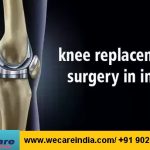CABG Surgery In India
What is coronary artery bypass graft (CABG) surgery?
 Coronary artery bypass grafting (CABG) is a type of surgery that improves blood flow to the heart. It’s used for people who have severe coronary heart disease (CHD), also called coronary artery disease.
Coronary artery bypass grafting (CABG) is a type of surgery that improves blood flow to the heart. It’s used for people who have severe coronary heart disease (CHD), also called coronary artery disease.
CHD is a condition in which a substance called plaque (plak) builds up inside the coronary arteries. These arteries supply oxygen-rich blood to your heart. Plaque is made up of fat, cholesterol, calcium, and other substances found in the blood.
Plaque can narrow or block the coronary arteries and reduce blood flow to the heart muscle. If the blockage is severe, angina (an-JI-nuh or AN-juh-nuh), shortness of breath, and, in some cases, heart attack can occur. (Angina is chest pain or discomfort.)
CABG is one treatment for CHD. During CABG, a healthy artery or vein from the body is connected, or grafted, to the blocked coronary artery. The grafted artery or vein bypasses (that is, goes around) the blocked portion of the coronary artery.
This creates a new passage, and oxygen-rich blood is routed around the blockage to the heart muscle.
Graft Preparation ?
Grafts used for bypass Surgery in India
-
- Internal mammary arteries [also called IMA grafts or internal thoracic arteries (ITA)] are the most common bypass grafts used, as they have shown the best long-term results. In most cases, these arteries can be kept intact at their origin because they have their own oxygen-rich blood supply, and then sewn to the coronary artery below the site of the blockage. If the surgeon removes the mammary artery from its origin, it is called a “free” mammary artery. Over the last decade, more than 90% of all patients received at least one internal artery graft.
-
- The radial (arm) artery is another common type of arterial graft. There are two arteries in the arm, the ulnar and radial arteries. Most people receive blood to their arm from the ulnar artery and will not have any side effects if the radial artery is used. Careful preoperative and intraoperative tests determine if the radial artery can be used. If the radial artery is used as the graft, the patient may be required to take a calcium channel blocker medication for several months after surgery. This medication helps keep the artery open. Some people report numbness in the wrist after surgery. However, long-term sensory loss or numbness is uncommon.
- Saphenous veins can be used as bypass grafts. Minimally invasive saphenous vein removal does not require a long incision. One to two incisions are made at the knee and a small incision is made at the groin. This results in less scarring and a faster recovery. Your surgeon will decide if this method cardiac bypass surgery is a good option for you.
- The gastroepiploic artery to the stomach and the inferior epigastric artery to the abdominal wall are less commonly used for grafting.
 What To Expect After Surgery in India?
What To Expect After Surgery in India?
After surgery, there will be a short stay (1 to 2 days if there are no complications) in the intensive care unit (ICU).
In the ICU, you will likely have : –
- Continuous monitoring of your heart activity.
- A tube to temporarily help with breathing.
- A central line, which is a thin plastic tube inserted into a vein in the neck and threaded down into the heart and pulmonary artery. It is used to monitor pressures and blood flow within the heart.
- A tube to remove stomach secretions until you start eating again.
- A tube (catheter) to drain the bladder and measure urine output.
- Tubes connected to veins in the arms (intravenous, or IV, lines) through which fluids, nutrition, and medicine can be given.
- An arterial line to measure blood pressure. An arterial line is a short, soft, plastic tube (a catheter) that is placed directly into an artery. The arterial line leads to a monitor, which continuously displays your blood pressure.
- Chest tubes to drain the chest cavity of fluid and blood (which is temporary and normal) after surgery.
After Surgery in India
After the grafts have been completed during the “on pump” procedure, the heart-lung machine is turned off, the heart starts beating on its own, and the flow of blood returns to normal.
Temporary pacing wires and a chest tube to drain fluid are placed before the sternum is closed with special sternal wires. Then the chest is closed with internal stitches or traditional external stitches. Sometimes a temporary pacemaker is attached to the pacing wires to regulate the heart rhythm until your condition improves.
Recovery in India
Full recovery from coronary artery bypass graft surgery takes about 2 months, or may be sooner if minimally invasive surgery techniques were used. Most patients are able to drive in about 3 to 8 weeks after surgery. Your doctor will provide specific guidelines for your recovery and return to work, including specific instructions on activity and how to care for your incision and general health after the surgery.
Follow Up Care in India
During the first few months after surgery, you will probably need to visit a few times with the doctor who referred you for surgery. You will need to schedule regular appointments with your cardiologist (even if you have no symptoms).
Your follow-up appointments may be scheduled every year, or more often, as recommended by your doctor. Your appointments should include a medical exam. Diagnostic studies (such as an echocardiogram) may be repeated at regular intervals.
You should call your doctor if your symptoms become more severe or frequent. Don’t wait until your next appointment to discuss changes in your symptoms.
How Well It Works ?
Although the immediate risks of coronary artery bypass graft surgery are greater than those of angioplasty, long-term outcomes are similar for both procedures. CABG surgery may offer the advantages of greater durability and more complete revascularization. Generally, the greater the extent of coronary atherosclerosis, the greater the benefits of bypass surgery over angioplasty.
Bypass surgery may be considered a better option for some people who have : –
- Diabetes.
- Disease of the left main coronary artery.
- Weakened heart muscle.
- Valve disease and need surgery.
Bypass surgery often relieves symptoms of chest pain (angina), improves exercise performance, and reduces the risk of a future heart attack.
People with severe coronary artery disease (CAD) have an increased risk of death within a year when they are treated with bypass surgery rather than medicines alone. But 5 to 10 years after bypass surgery, the risk of death from CAD is less for those who had surgery compared with those treated with medicine. Factors that affect these results include the number of coronary arteries that are diseased, the severity of the disease, and the location of the plaque in the coronary arteries.
List Of Other CABG Surgery Offered In India















